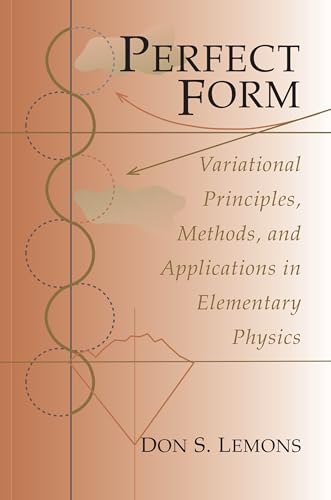
Inhaltsangabe
What does the path taken by a ray of light share with the trajectory of a thrown baseball and the curve of a wheat stalk bending in the breeze? Each is the subject of a different study yet all are optimal shapes; light rays minimize travel time while a thrown baseball minimizes action. All natural curves and shapes, and many artificial ones, manifest such "perfect form" because physical principles can be expressed as a statement requiring some important physical quantity to be mathematically maximum, minimum, or stationary. Perfect Form introduces the basic "variational" principles of classical physics (least time, least potential energy, least action, and Hamilton’s principle), develops the mathematical language most suited to their application (the calculus of variations), and presents applications from the physics usually encountered in introductory course sequences.
The text gradually unfolds the physics and mathematics. While other treatments postulate Hamilton’s principle and deduce all results from it, Perfect Form begins with the most plausible and restricted variational principles and develops more powerful ones through generalization. One selection of text and problems even constitutes a non-calculus of variations introduction to variational methods, while the mathematics more generally employed extends only to solving simple ordinary differential equations. Perfect Form is designed to supplement existing classical mechanics texts and to present variational principles and methods to students who approach the subject for the first time.
Die Inhaltsangabe kann sich auf eine andere Ausgabe dieses Titels beziehen.
Über die Autorin bzw. den Autor
Don S. Lemons is Associate Professor of Physics at Bethel College of North Newton, Kansas.
Von der hinteren Coverseite
What does the path taken by a ray of light share with the trajectory of a thrown baseball and the curve of a wheat stalk bending in the breeze? Each is the subject of a different study yet all are optimal shapes; light rays minimize travel time while a thrown baseball minimizes action. All natural curves and shapes, and many artificial ones, manifest such "perfect form" because physical principles can be expressed as a statement requiring some important physical quantity to be mathematically maximum, minimum, or stationary. Perfect Form introduces the basic "variational" principles of classical physics (least time, least potential energy, least action, and Hamilton's principle), develops the mathematical language most suited to their application (the calculus of variations), and presents applications from the physics usually encountered in introductory course sequences.
„Über diesen Titel“ kann sich auf eine andere Ausgabe dieses Titels beziehen.
Weitere beliebte Ausgaben desselben Titels
Suchergebnisse für Perfect Form: Variational Principles, Methods, and...
Perfect Form
Anbieter: Wonder Book, Frederick, MD, USA
Zustand: Good. Good condition. A copy that has been read but remains intact. May contain markings such as bookplates, stamps, limited notes and highlighting, or a few light stains. Artikel-Nr. J06B-04070
Perfect Form: Variational Principles, Methods, and Applications in Elementary Physics
Anbieter: Anybook.com, Lincoln, Vereinigtes Königreich
Zustand: Good. This is an ex-library book and may have the usual library/used-book markings inside.This book has soft covers. In good all round condition. Please note the Image in this listing is a stock photo and may not match the covers of the actual item,350grams, ISBN:9780691026633. Artikel-Nr. 3719119
Gebraucht kaufen
Anzahl: 1 verfügbar
Perfect Form Variational Principles, Methods, & Applications in Elementary Physics (Paper)
Anbieter: Revaluation Books, Exeter, Vereinigtes Königreich
Paperback. Zustand: Brand New. 144 pages. 9.25x6.25x0.50 inches. In Stock. Artikel-Nr. x-0691026637
Neu kaufen
Anzahl: 2 verfügbar
Perfect Form: Variational Principles, Methods, and Applications in Elementary Physics
Anbieter: Kennys Bookstore, Olney, MD, USA
Zustand: New. Introduces the basic 'variational' principles of classical physics, develops the mathematical language suited to their application, and presents applications from the physics encountered in introductory course sequences. This book is designed to supplement classical mechanics texts and to present variational principles and methods to students. Num Pages: 136 pages, 39 line illus. BIC Classification: PHD. Category: (P) Professional & Vocational; (U) Tertiary Education (US: College). Dimension: 229 x 152 x 8. Weight in Grams: 171. . 1997. Paperback. . . . . Books ship from the US and Ireland. Artikel-Nr. V9780691026633

